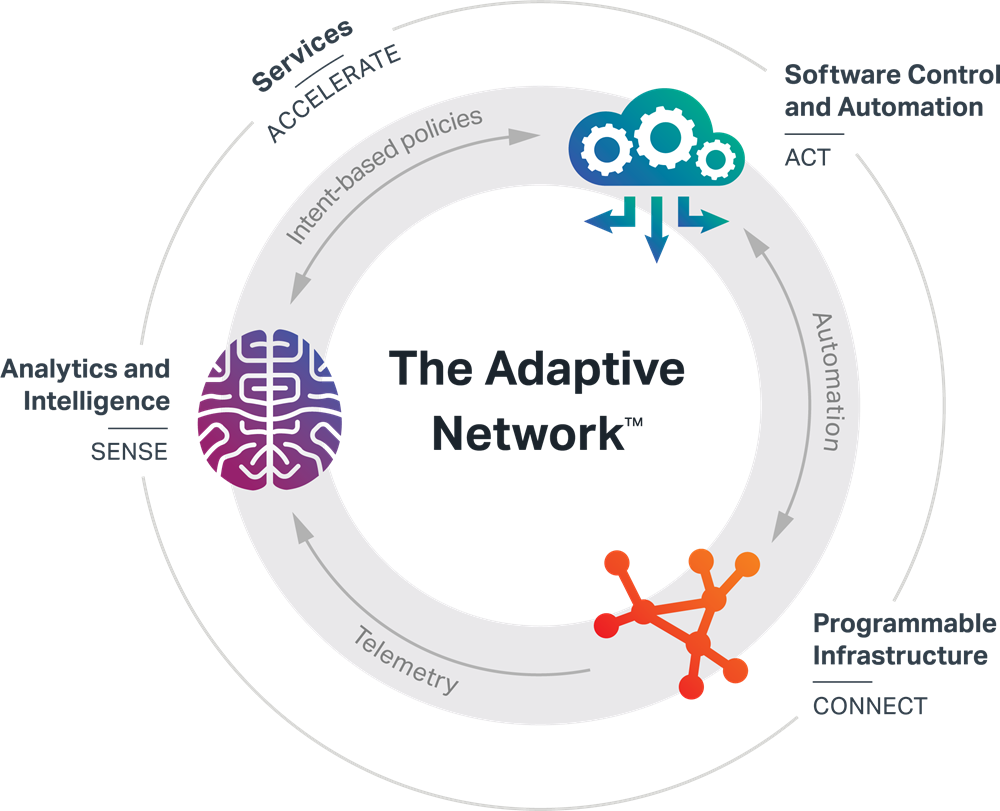The Adaptive Network: Why automation alone isn’t enough
Just imagine, instead of 70, your heart rate was at 100 beats per minute. This could be a warning sign that you are on the verge of having a heart attack.
If your doctor were to get this information in real time, they could check the readings against your medical records and see that this is completely out of the norm and then warn you to seek medical assistance immediately. However, if your personal trainer received that same information, would they reach the same conclusion as your doctor? Your trainer has access to a different database, which might show your resting heart rate as well as the rate during high-intensity training. Knowing that you are likely exercising, they would instead conclude that there is no need to go to the hospital after all.
This clearly demonstrates that just accepting raw data without filtering and proper analysis is no longer good enough and can potentially have serious repercussions. Instead, it is critical that we have diversity of thought when it comes to how we interpret data. This is not just true for our health or other day-to-day scenarios, but can also be applied to the communication networks that carry and house our information.
To achieve this, the network must not only be autonomous at some level; it needs to be able to adapt, configure and maintain itself constantly. But note - with increased automation there is a risk that the network can become too rigid and potentially take inappropriate action without assessing the wider context.
This is why we need networks with ‘intent-based’ control that take advantage of software automation without relinquishing complete control. Intent-based control will help guide the network to react appropriately to changing user demands and unexpected issues. Now more than ever, we need to make sure that our networks are not just autonomous, but adaptive.



European operators are adapting now
European operators are preparing for the vast connectivity required for the internet of things (IoT), and 5G – the technology that will support real-time access to, and sharing of, information like health records between your trainer and doctor. But this is not without its challenges. Being connected is becoming cheaper; while IoT and mobility are pushing zettabytes of data per year. Demand is far outpacing fixed line connectivity, and the revenue from these data services continues to decline.
Business users are moving from buying individual products to purchasing services, like access to cloud-based solutions. And at home, users are after convenience, which is driving the convergence of fixed lines, TV and broadband. There is also a more intent focus on increasing broadband investment, and the quest for rural broadband continues – such as the EU's ambitious initiatives to provide half of European households with at least 100Mbps by 2020.
So, operators are having to seek new opportunities, expand into new areas, extend their product sets, and embrace cross-industry partnerships. In essence, they are adapting; converting from offering single mobile, voice and data services to a full range of converged services incorporating mobile and fixed-line services as well as content and digital media.
Key Aspects of the Adaptive Network
An Adaptive NetworkTM leverages artificial intelligence, machine learning and software analytics to examine the many data points being generated at any given time so that the network can react to end user demands and adjust without human interaction. This is possible thanks to sophisticated software capabilities that uncover deep, meaningful patterns in data or content to help organizations – or in this case, their networks – make intelligent decisions.
Built upon three key elements – software control and automation, analytics and intelligence, and programmable infrastructure – the Adaptive Network allows network operators to evolve their current infrastructures so their network becomes a communication loop that relays information from network elements, instrumentation, users and applications, through to a software layer for analysis and action.

EMEA operators are taking this path now - moving from evaluation to adoption of new networking technologies. On the most part, avoiding large-scale rip and replace, and choosing consistent and steady evolution that perfects one change before moving to the next, adapting and learning all the while. We are seeing operators take up new partnerships to serve future high-bandwidth demands, pioneer new levels of network-to-network interoperability, move to multi-layer, multi-vendor solutions, and enabling new services such as allowing enterprise customers the ability to instantly provision virtual network functions (VNF) on demand with self-service ordering capabilities.
EMEA operators are taking this path now - moving from evaluation to adoption of new networking technologies. On the most part, avoiding large-scale rip and replace, and choosing consistent and steady evolution that perfects one change before moving to the next, adapting and learning all the while.
By embarking on this journey to the Adaptive Network as an evolution, these operators are going beyond autonomous networking; making their infrastructure more programmable and intelligent one step at a time, allowing the network to be flexible and grow with the company and their needs. These operators also realise that to make the Adaptive Network a success, it is important to have a choice of providers and that the automation software works across multiple vendors. By embracing openness, they can select the technology that best meets their needs when it comes to operational fit, performance, power consumption and telemetry. This will result in sharp reduction of costs, increased agility and a highly flexible network architecture that can evolve to take advantage of any future innovations.
It’s about interpreting the data
Data, both big and small, has an impact upon all of us, and to use it to our greatest advantage, we should analyse it appropriately. Just as a doctor and personal trainer must analyse your heartbeat differently, the network needs to be intelligent and flexible so that it can gather both small data (things that happen very quickly, like a customer’s heart rising abnormally) and big data (key trends that allow the network to anticipate failures before they happen) and then makes policy-based decisions. The Adaptive Network can do this. For example, one of the policy choices may be to allow human review and/or intervention, which a completely autonomous network doesn’t permit.
By ensuring there is a human element behind networking control and management, the Adaptive Network will identify problems before they occur, whilst ensuring optimal control by an experienced technician. This will allow network providers to offer networks which boast speed, efficiency, and reliability.
As traffic from mobile broadband and IoT increases, there will be a surge in the amount of data passing through operator networks. To ensure they can cope with these rising demands, operators will need to forge more effective partnerships between humans and machines, to create agile and adaptive networks that can overcome emerging market challenges, today – and tomorrow.





